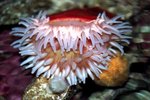
The purple starfish or ochre sea star is found in the rocky shorelines of the Pacific Ocean from Prince William Sound, Alaska, to Baja, California. In addition to its colorful hue, this large, sturdy echinoderm is known for its healthy shellfish appetite and its ability to live for hours in oxygen-rich shallow water.
Appearance
Though the purple starfish (Pisaster ochraceus) got its name for its varying shades of purple, the attractive echinoderm's coloration may also be orange, yellow or brown. Typically found with five arms, the ochre sea star may have only three or four, or as many as seven. Its bulky, spine-covered body can grow to 10 inches from arm to arm and may weigh close to a pound.
Habitat
This large, attractive sea star is native to the Pacific Ocean, often found hiding in the crevices of rocks in the coastlines of California and Alaska. Because it can tolerate high levels of oxygen for eight hours or longer, the starfish species is frequently found at the water's edge where the waves meet the shore. The ochre sea star does not thrive in hot, shallow waters, however, and is not commonly found in shallow tide pools. It spends time in deeper waters, especially during spawning and during the winter months.
Diet and Feeding
The ochre sea star is a predatory carnivore that feeds on a diet of mussels, clams, limpets, snails and barnacles. Using small tubelike structures on the ends of its arms, the large purple starfish pries open its prey. The purple starfish has a tubelike stomach, too; it extends and inserts into the shell of its prey to eat.
Reproduction
Purple starfish reproduction begins with spawning during the months of May, June and July. The males and females spend these months in deeper ocean waters where they release sperm and eggs into the sea. A large female weighing around 14 ounces or more may broadcast as many as 40 million eggs during the spawn. The starfish sperm and eggs join together without the assistance of the parents, resulting in fertilization. The resulting free-swimming embryos have no interaction other than incidental with their parent sea stars. Young purple starfish spend around six months feeding off plankton until they are large enough to begin hunting shellfish closer to shore. Purple starfish can reproduce asexually, as well, when a portion of the echinoderm fragments from the main part of the body and grows into a separate organism.
Predators and Life Expectancy
With the exception of gulls and otters, the purple starfish has few predators and may live up to 20 years. It is most vulnerable in its juvenile stage of life, when it is smaller and prone to being devoured by other sea-dwelling animals. Once it reaches maturity at about 5 years, however, its large, durable body covering and bright colors keep most predators at bay.
References
- World Association of Zoos and Aquariums: Ochre Sea Star
- The Pacific Wildlife Foundation: Ochre Sea Star Pisaster Ochraceus
- Walla Walla Edu: Pisaster Ochraceus (Brandt, 1835)
- King County Aminals, Plants and Habitat: Purple Sea Star Pisaster Ochraceus
- Marine Education Society of Australasia: Echinoderms Sea Stars
Resources
Photo Credits
-
purple starfish image by Carbonbrain from Fotolia.com
Writer Bio
Jennifer Lynn has been writing as a correspondent and reporter since 1991. She has written for numerous newspapers and currently writes as a correspondent for Gannett. Lynn has a Bachelor of Arts with a focus on English from Ohio University, where she also studied journalism at the E.W. Scripps School of Journalism.



